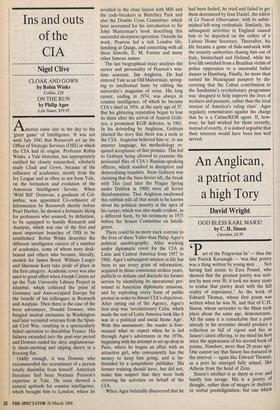Ins and outs of the CIA
Nigel Clive
CLOAK AND GOWN by Robin Winks
Collins, £20
ON THE RUN by Philip Agee
Lyle Stuart, $19.95
America came late in the day to the 'great game' of Intelligence. It was not until July 1941 that Roosevelt set up the Office of Strategic Services (OSS) in which the CIA had its origins. Professor Robin Winks, a Yale historian, has appropriately entitled his closely researched, scholarly study Cloak and Gown, because of the influence of academics, mostly from the Ivy League and as often as not from Yale, on the formation and evolution of the American Intelligence Service. When `Wild Bill' Donovan, a graduate of Col- umbia, was appointed Co-ordinator of Information by Roosevelt shortly before Pearl Harbor, he showed a fortunate liking for professors who seemed, by definition, to be equipped to handle Research and Analysis, which was one of the first and most important branches of OSS to be established. Robin Winks describes the different intelligence careers of a number of academics, some of whom were desk- bound and others who became, literally, models for James Bond. William Langer and Sherman Kent take pride of place in the first category. Academic cover was also used to good effect when Joseph Curtiss set up the Yale University Library Project in Istanbul, which collected the press of Germany and Axis-occupied Europe for the benefit of his colleagues in Research and Analysis. Then there is the case of the born adventurer, Donald Downes, who burgled neutral embassies in Washington and later recruited veterans from the Span- ish Civil War, resulting in a spectacularly failed operation to destabilise Franco. His failures extended into the post-war period and Downes ended his days unglamorous- ly chain-smoking and sipping sherry in a freezing flat.
Oddly enough, it was Downes who recommended the recruitment of a person totally dissimilar from himself. American literature had been Norman Pearson's expertise at Yale. He soon showed a natural aptitude for counter intelligence, which brought him to London, where he revelled in the close liaison with MI6 and the code-breakers in Bletchley Park and also the Double Cross Committee: which later accounted for his introduction to Sir John Masterman's book describing this successful deception operation. Outside his work, Pearson led a rich London life, lunching at Quags, and consorting with all three Sitwells, E. M. Forster and many other famous names.
The last biographical essay analyses the career and personality of Pearson's war- time assistant, Jim Angleton. He had entered Yale as an Old Malvernian, spring- ing to intellectual fame by editing the university's magazine of verse. His long career, ending in 1974, was always in counter intelligence, of which he became CIA's chief in 1954, at the early age of 37. But his glittering reputation began to lose its shine after the arrival of Anatoli Golit- syn, a prominent KGB defector, in 1961. In his debriefing by Angleton, Golitsyn planted the story that there was a mole in the CIA. Angleton believed him or, to use smarter language, his methodology re- quired acceptance of that premise. This led to Golitsyn being allowed to examine the personnel files of CIA's Russian-speaking officers, which resulted in disruptive and demoralising transfers. Soon Golitsyn was claiming that the Sino-Soviet rift, the break with Tito (and later the Prague Spring under Dubdek in 1968) were all Soviet disinformation. That Angleton swallowed this rubbish tells all that needs to be known about his political insanity at the apex of his career; which was also made evident, in a different form, by his testimony in 1975 before the Senate Committee on Intelli- gence.
There could be no more stark contrast to the lives of these Yalies than Philip Agee's political autobiography. After working under diplomatic cover for the CIA in Latin and Central America from 1957 to 1968, Agee's subsequent mission in life has been to use every grain of information, acquired in those conscience-striken years, publicly to defame and discredit his former service by identifying its operational per- sonnel in American diplomatic missions, and by exploiting every form of public protest in order to thwart CIA's objectives. After opting out of the Agency, Agee's first stop was 'revolutionary Cuba, which made the rest of Latin America look like it was in a political and social Stone Age'. With this assessment, the reader is fore- warned what to expect when he is led through Agee's adventures in the 1970s, beginning with his attempt to set up shop in Paris, where he begins an affair with an attractive girl, who conveniently has the money to keep him going, and is be- friended by a sympathetic publisher. His former training should have, but did not, make him suspect that they were both covering his activities on behalf of the CIA.
When Agee belatedly discovered that he had been fooled, he tried and failed to get them denounced by Jean Daniel, the editor of Le Nouvel Observateur, with its unble- mished left-wing credentials. Similarly, his subsequent activities in England caused him to be deported on the orders of a Labour Home Secretary. Thereafter, his life became a game of hide-and-seek with the security authorities chasing him out of Italy, Switzerland and Holland, while his love life switched from a Brazilian victim of police oppression to a successful ballet dancer in Hamburg. Finally, he more than earned his Nicaraguan passport by dis- covering that the Cuban contribution to the Sandinista's revolutionary programme was 'designed to help improve the lives of workers and peasants, rather than the local version of America's ruling class'. Agee regularly remonstrates against the charge that he is a Cuban/KGB agent. If, how- ever, he had worked for them covertly, instead of overtly, it is indeed arguable that their interests would have been less well served.


















































 Previous page
Previous page